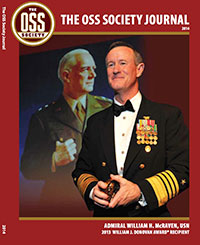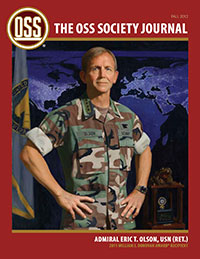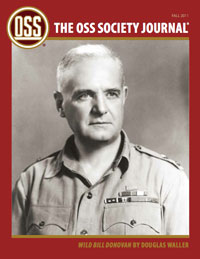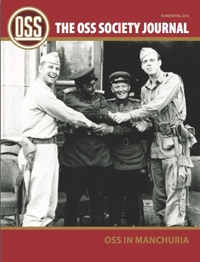American Intelligence in War-time London: The Story of the OSS
By Nelson MacPherson
Reviewed by Fisher Howe
This scholarly treatise – which its Canadian author for some reason calls historiography rather than history – presents a detailed, indeed exhaustive analysis of the London OSS office. He explains why: “The London mission was at the heart of OSS relations with British intelligence, and as such it personified the essence of that connection in the Allied war effort. The Allied invasion of Europe ensured that OSS/London, more than any other OSS outpost, would have the greatest opportunity to perform a decisive role in the intelligence war.”

These purposes the treatise largely achieves. However, while its scholarly dimension may be measured by the number of footnotes (46 for the 12 pages of Introduction text; 73 for the 19 pages of Chapter 4: 167 for 30 pages of Chapter 8), or the 30 pages of Bibliography, its scholarly merit should not be measured by the judgmental pronouncements that fill every chapter. Certainly people can disagree on the contribution of OSS and each of its branches to the war effort - to performing “a decisive role in the intelligence war.” That is controversial and open to all kinds of assessment. This treatise, be it understood, goes to considerable length to document an almost universally negative evaluation, sometimes using what would seem to be unscholarly judgmental language.
1. The British Intelligence Community: Setting the Tone for OSS
2. The Genesis of OSS/London, and the British Dimension
3. Servants of OVERLORD: SO, SI, and the Invasion of Europe
4. Reductio Ad Absurdum: R&A/London’s Quest for Relevance
5. Falling Short of the Target: EOU [Enemy Objectives Unit of R&A], SIRA [SI and R&A intelligence processing arrangement], and the Pitfalls of R&A
6. Inspired Improvisation: William Casey and the Penetration of Germa ny
7. Following the British Example: X-2 and Morale Operations
8. Full Circle: Anglo-American Intelligence and the Transition to Cold War.
These chapters present an enormously detailed account of the operations of the London office against the background of start-up turmoil within the neophyte intelligence agency, particularly with the centralization demands of Washington headquarters, the inter-branch rivalries both in Washington and the London outpost; and the ambivalence in the “competitive cooperation” with British organizations
The wartime evolution of the British Intelligence organizations and the comparable development of the OSS, largely in the British image, are well and interestingly presented. The assessments of the several OSS/London branches, however, while extensive and detailed, are quite uneven, in most cases critical. The author gives unstinting praise to Bill Casey’s SI efforts in the penetration of Germany, modest commendation for the JEDBURGH (SO and British SOE) and SUSSEX (SI and British SIS) operations in the OVERLORD invasion, but other OSS efforts are derided as naïve, confused, or just ineffective in the war effort.
R&A generally and R&A/London specifically suffer most in the analysis. According to the treatise, R&A, “in contradiction to its postwar reputation as a unique collection of scholarly operatives mobilized by an ingenious William Donovan”. . . “spent its existence in a desperate, if largely futile, struggle to secure a me aningful role.” Elsewhere, “R&A developed into a highly skilled irrelevancy”; throughout the war it kept trying to establish its basic mission – what customers it was to serve and with what kind of materials. At one point it goes to this extreme: The R&A/EOU [Enemy Objectives Unit] “illustrates the perversion of the intelligence cycle. . . [its] subordination of disinterested analysis and dissemination to the biased needs of its bloated collective ego.”
Our hero 109 does not come off at all well in this treatise. Donovan is depicted as a brilliant courageous leader but “often erratic and less than deft in dealing with the ferocious intricacies of the Washington and London power centers.” Later: “He never really directed his organization in any meaningful way.” And this: “Donovan’s reputation for erratic behavior, arrogant stubbornness, and blatant ambition determined OSS's fate by alienating the military.” Also: his ‘authoritarian attitude’ and ‘zealous inability to consider any other point of view than his own’.” Finally: “Donovan’s shortcomings were compounded by his erratic behavior and all of these factors contributed by 1945 to a widespread antipathy for Donovan personally which gravely undermined his attempts at securing OSS as the postwar intelligence bureaucracy.”
The treatise contains one unforgivable blooper: in several key places it totally confuses two peop le named William Phillips. One Phillips was a rather shady intelligence operative who showed up in the early days of the London office with vague connections to Washington intelligence agencies. He was mistrusted and disliked by the British. An unflattering description of him and his role by London’s director, David Bruce is fully reported. This Phillips was never, as the treatise wrongly reports, given a responsible role in OSS/London. The other William Phillips was no less than the very distinguished U.S. Ambassador whom Donovan sent to be the second director of OSS/London, succeeding W. D. Whitney and preceeding David K.E. Bruce. Ambassador Phillips gets no mention whatsoever in the treatise
Surprisingly, the conclusions drawn in the final chapter of the treatise present a much more balanced picture, quite unlike the chapter evaluations, and give a constructive and interesting overall assessment, part of which is worth repeating:
The British connection’s significance to American intelligence is clear. US intelligence was not shaped by one Machiavellian manipulation by SIS and SOE, or by the prophetic genius of William Donovan. It was instead moulded through the forging of an Anglo-American intelligence partnership that paved the way for realizing a concrete capacity for professional American intelligence. The British intelligence establishment did not tutor OSS/London per se. The various OSS branches were instead accepted by their British counterparts as partners in joint endeavo rs, in the course of which OSS/London achieved an accelerated capability which matched, and in some cases surpassed, that of the British services. X-2 and SO certainly produced efforts equivalent to those of MI6(V) and SOE in northern Europe. SI not only kept pace with Broadway’s operational record in France, but it went on to out-perform MI6 in penetrating Germany. . . .MO’s efforts were limited by the problematic nature of its work, whereas R&A served mainly as an underachieving disappointment that hinted at the possibilities of applying scholarly methods to intelligence analysis without matching those already attained by Britain. The potential would remain unrealized in America until CIA’s formation.







